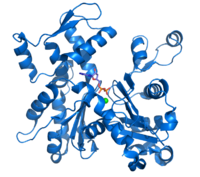
Photo from wikipedia
Peptidylarginine deiminase 2 (PAD2) is a Ca2+-dependent enzyme that catalyzes the conversion of protein arginine residues to citrulline. This kind of structural modification in histone molecules may affect gene regulation,… Click to show full abstract
Peptidylarginine deiminase 2 (PAD2) is a Ca2+-dependent enzyme that catalyzes the conversion of protein arginine residues to citrulline. This kind of structural modification in histone molecules may affect gene regulation, leading to effects that may trigger several diseases, including breast cancer, which makes PAD2 an attractive target for anticancer drug development. To design new effective inhibitors to control activation of PAD2, improving our understanding of the molecular mechanisms of PAD2 using up-to-date computational techniques is essential. We have designed five different PAD2–substrate complex systems based on varying protonation states of the active site residues. To search the conformational space broadly, multiple independent molecular dynamics simulations of the complexes have been performed. In total, 50 replica simulations have been performed, each of 1 μs, yielding a total simulation time of 50 μs. Our findings identify that the protonation states of Cys647, Asp473, and His471 are critical for the binding and localization of the N-α-benzoyl-l-arginine ethyl ester substrate within the active site. A novel mechanism for enzyme activation is proposed according to near attack conformers. This represents an important step in understanding the mechanism of citrullination and developing PAD2-inhibiting drugs for the treatment of breast cancer.
Journal Title: Biochemistry
Year Published: 2022
Link to full text (if available)
Share on Social Media: Sign Up to like & get
recommendations!